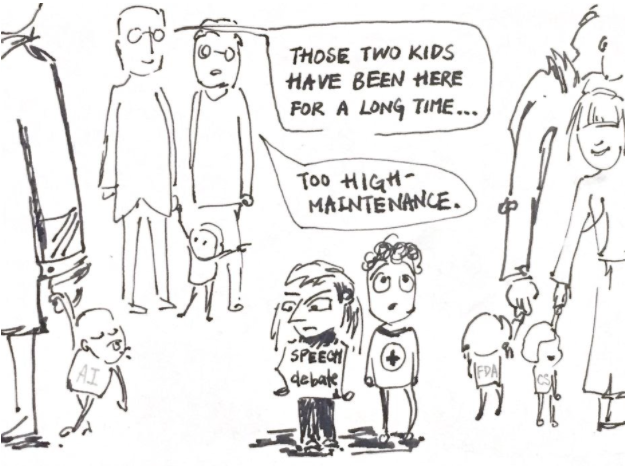The members of the speech and debate team started the year on a sour note. Coming out of a year of purely online practices and tournaments, they found themselves with few returning underclassmen and barely any money. Even worse, they had no no coach and adviser, either.
This trend, however, is not specific to just the speech and debate program: Clubs all over school are struggling, in part because of the enormous difficulty of finding willing advisers at a time of restricted room access at lunch. The best solution might be the toughest one: Cut back on the number of clubs so that the surviving ones are more likely to thrive while also incentivizing more participation on the part of teachers.
Difficulty in finding an adviser
For an organization like speech and debate, infamous for the insane time commitment it entails for all parties involved, the dependence on an adviser is obvious, but it’s not just that: Established low-maintenance clubs are having issues as well.
The presidents of the Red Cross Club, for example, had to ask five teachers before finally finding a teacher willing to take on the role. The Red Cross doesn’t even require an adviser to have any responsibilities besides keeping an open room during one lunch period every other week and signing volunteering hour forms.
Don’t get us wrong; teachers are not at fault for not wanting to take on extra work for no compensation in an already difficult year. Even low-maintenance clubs do take up some time — time that teachers, especially amidst this weird transition back to 90-minute classes, 10-minute passing periods and in-person learning, simply feel they do not have — and in situations like these, it’s essential for the leadership at this school (both ASB and the higher administration) to step forward with solutions.
In fact, ASB’s job description states that, in the event that a club lacks an adviser, the club commissioners either help the club find an adviser or help the club settle down and maintain their club status while they’re in the process of finding an adviser.
Yet ASB fulfilling that duty is only a surface-level solution to this issue: The administration must craft solutions that incentivize reasons for teachers to help clubs.
In other industries, professionals aren’t expected to do extra work without any sort of reward. Why are teachers expected to give away their time and energy with zero financial compensation?
The administration and district leadership could start equating being a club adviser to something like teaching extra hours for pay. Some clubs such as speech and debate offer stipends for teacher advisers: An idea that can be further implemented to spread compensation to more club advisers as well.
Before the COVID-19 pandemic, most clubs met during lunch, allowing members to simultaneously eat their lunch and participate in the meeting. However, due to the safety restrictions put in place this year, students are no longer allowed to eat indoors. Whatever interest students had after participating in a disorientating year online is only evaporating since students are basically forced to choose between eating and going to club meetings.
Clubs are unable to maximize their already limited meeting time since students show up 10 to 15 minutes late, rushing after they shove their lunches down their throats as quickly as they can — not to mention that lunch is technically 10 minutes shorter this year. While this problem seems almost unavoidable in order to keep students and staff safe, the ASB could allocate areas for clubs to have meetings outdoors and set up tents and projectors for members to use or even encourage clubs to use tutorials to meet instead.
Going back online
Due to all these obstacles, many clubs have been forced to resort to the pre-vaccination method: Zoom. Genomics and Bioinformatics, for example, was forced to conduct club meetings online until they could find a teacher adviser — which is awful, since club retention and quality were both lackluster last year because students were unable to grasp the full concept of what clubs had to offer.
There simply just aren’t enough rooms and teachers for the number of clubs that have been introduced to the school. At this point, the most obvious and tangible solution seems to be cutting the number of clubs.
The current (non updated) club list consists of 65 clubs, a number which even excludes the stream of new clubs created over the COVID-19 year — Females for Finance, Sports Business/Statistics, Dear Asian Youth and more. There is a ratio of just around 19 students per club. An increase in the number of clubs leads to higher competition among them; this hurts both the clubs and the students.
Whatever the solution is, it needs to be implemented as soon as possible. With the growing quantity of clubs, their quality is declining.
Clubs are a crucial and necessary part of the high school experience; they’re a place for students to bond, learn more about their interests and pursue new ones. As a school community, we should find ways to help protect this valuable experience before it becomes an endangered species.


























